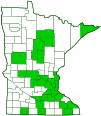celandine
(Chelidonium majus)
Conservation • Wetland • Description • Habitat • Ecology • Use • Distribution • Taxonomy
Description |
||
Celandine, also called greater celandine, is a 12″ to 32″ tall, erect, biennial or perennial forb that rises on leafy stems from a thick, sometimes branched, underground stem (rhizome). It spreads by seed. The first year the plant appears as a rosette of several basal leaves. In the second year it produces one or more leafy aerial stems. Stems are 12″ to 32″ long, sprawling to strongly ascending, ribbed, and sometimes branched. They are covered with a whitish, waxy substance (glaucous) and are sparsely covered with fine, more or less spreading hairs. Stems and leaves exude a yellow to yellowish-orange sap when torn. The sap is toxic and irritating to the skin. Basal leaves are up to 12″ long and up to 6″ wide, and are on leaf stalks (petioles) that are up to 4″ long. The petiole and central axis (rachis), if present, are sparsely hairy. The leaf blades are deeply pinnately divided, sometimes to the midrib, into 5 to 9 lobes or leaflets. The lobes/leaflets are egg-shaped or inversely egg-shaped in outline and rounded at the tip. The upper surface is green and hairless. The lower surface is pale, glaucous, sparsely hairy or hairless, and conspicuously veined. The margins are bluntly toothed, irregularly scalloped, and usually also shallowly to deeply lobed. Stem leaves are on shorter leaf stalks but are otherwise similar to basal leaves. The inflorescence is an umbrella-like cluster (umbel) of a few flowers, sometimes just a single flower, at the end of the stem and sometimes also from upper leaf axils. The flowers are ½″ to ¾″ in diameter. They are on 3 ⁄16″ to 1⅜″ long stalks (pedicels). The pedicels are only slightly inflated at the top, not forming a cup or disk. There are 2 sepals, 4 petals, 12 to 30 stamens, and 1 pistil. The sepals are hairless, 5 ⁄16″ to ½″ long, broadly egg-shaped, and broadly pointed at the tip. They are deeply concave, forming a cup around the developing flower. They are not fused together into a cap. They drop off as the flower opens. The petals are bright yellow, 5 ⁄16″ to 9 ⁄16″ long and wide, broadly inversely egg-shaped, and rounded at the tip. They are similar in size and shape and are not fused at the base. There is a double-flowered form of this plant that produces flowers with 12 to 24 petals each. The stamens have small yellow anthers. The filaments are not fused together. The pistil is formed of two fused carpels and is attached above the point of attachment of the petals (superior). It is green, narrow, and about as long or slightly longer than the stamens. At the tip of the pistil there is a single 1 ⁄64″ to 1 ⁄32″ long style with a white, more or less cap-like stigma. The fruit is an ascending, hairless, ¾″ to 2″ long seed capsule containing numerous seeds. It is narrowly cylinder-shaped, slender, widest at the base, and tapered to the tip, where the persistent style is still attached. When ripe it splits open longitudinally from the base. The seeds are spread by ants, ant-eating birds, and humans. |
||
Height |
||
12″ to 32″ |
||
Flower Color |
||
Yellow |
||
Similar Species |
||
No similar species in Minnesota. Celandine poppy (Stylophorum diphyllum) flowers are much larger, up to 2¼″ in diameter. The sepals are hairy. The fruits are ellipse-shaped, bristly-hairy, and nodding. It does not occur in Minnesota. |
||
Habitat |
||
Moderately moist. Gardens, woodlands, thickets, hedge rows, roadsides, railroads, waste places. Full sun to light shade. |
||
Ecology |
||
Flowering |
||
May to August |
||
Pests and Diseases |
||
|
||
Toxicity |
||
Celandine sap is bright yellow or yellowish-orange and toxic. It is a skin irritant and has been used medicinally to treat warts. |
||
Use |
||
|
||
Distribution |
||||
|
Sources |
|||
| 3/23/2023 | ||||
Nativity |
||||
Native to Europe, Asia, and North Africa. Introduced and cultivated as an ornamental. Occasionally escapes cultivation. Established. |
||||
Occurrence |
||||
Uncommon in Minnesota |
||||
Taxonomy |
|||
| Kingdom | Plantae (green algae and land plants) | ||
| Subkingdom | Viridiplantae (green plants) | ||
| Infrakingdom | Streptophyta (land plants and green algae) | ||
| Superdivision | Embryophyta (land plants) | ||
| Division | Tracheophyta (vascular plants) | ||
| Subdivision | Spermatophytina (seed plants) | ||
| Class | Magnoliopsida (flowering plants) | ||
| Superorder | Ranunculanae | ||
Order |
Ranunculales (buttercups, poppies, and allies) | ||
Family |
Papaveraceae (poppy) | ||
| Subfamily | Papaveroideae | ||
| Tribe | Chelidonieae | ||
Genus |
Chelidonium (celandines) | ||
Subordinate Taxa |
|||
Synonyms |
|||
Chelidonium majus var. laciniatum Chelidonium majus var. majus Chelidonium majus var. plenum Chlidonium majus |
|||
Common Names |
|||
celandine great celandine greater celandine nipplewort rock-poppy swallowwort |
|||
Glossary
Carpel
The female reproductive organ of a flower, consisting of an ovary, styles, and stigmas.
Filament
On plants: The thread-like stalk of a stamen which supports the anther. On Lepidoptera: One of a pair of long, thin, fleshy extensions extending from the thorax, and sometimes also from the abdomen, of a caterpillar.
Glaucous
Pale green or bluish gray due to a whitish, powdery or waxy film, as on a plum or a grape.
Pedicel
On plants: the stalk of a single flower in a cluster of flowers. On insects: the second segment of the antennae. On Hymenoptera and Araneae: the narrow stalk connecting the thorax to the abdomen: the preferred term is petiole.
Petiole
On plants: The stalk of a leaf blade or a compound leaf that attaches it to the stem. On ants and wasps: The constricted first one or two segments of the rear part of the body.
Pinnate
On a compound leaf, having the leaflets arranged on opposite sides of a common stalk. On a bryophyte, having branches evenly arranged on opposite sides of a stem.
Rachis
The main axis of a compound leaf, appearing as an extension of the leaf stalk; the main axis of an inflorescence.
Rhizome
A horizontal, usually underground stem. It serves as a reproductive structure, producing roots below and shoots above at the nodes.
Rosette
A radiating group or cluster of leaves usually on or close to the ground.
Sepal
An outer floral leaf, usually green but sometimes colored, at the base of a flower.
Umbel
A flat-topped or convex, umbrella-shaped cluster of flowers or buds arising from more or less a single point.
Visitor Photos |
|||||
Share your photo of this plant. |
|||||
| This button not working for you? Simply email us at info@MinnesotaSeasons.com. Attach one or more photos and, if you like, a caption. |
|||||
|
|||||
MinnesotaSeasons.com Photos |
|||||
Habitat |
|||||
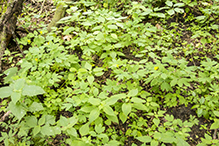 |
|||||
Plant |
|||||
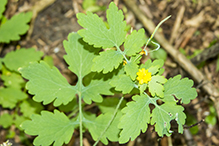 |
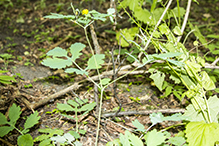 |
||||
Flower of Double-flowered Form |
|||||
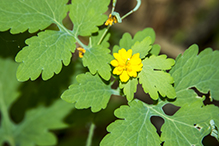 |
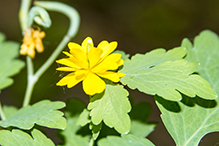 |
||||
Leaves |
|||||
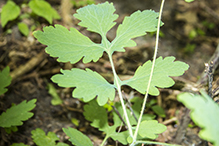 |
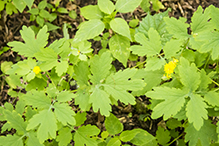 |
||||

Slideshows |
||
| Chelidonium majus Belack Darko |
||
About
Uploaded on May 19, 2011 More information?? Review: http://www.pfaf.org/user/Plant.aspx?LatinName=Chelidonium%20majus |
||

Visitor Videos |
|||
Share your video of this plant. |
|||
| This button not working for you? Simply email us at info@MinnesotaSeasons.com. Attach a video, a YouTube link, or a cloud storage link. |
|||
Other Videos |
|||
| Greater Celandine (Chelidonium majus) - 2012-05-06 Westdelta |
|||
About
Published on May 9, 2012 Chelidonium majus (greater celandine; in Europe tetterwort, although in America the same name refers to bloodroot) is a herbaceous perennial plant, the only species in the genus Chelidonium. ---------------- |
|||
| Lara Greenspan on Greater Celandine swirlysunburst |
|||
About
Uploaded on May 23, 2010 Lara Greenspan on Greater Celandine |
|||
| Greater Celandine - Stinkende Gouwe - Chelidonium majus dreamshot |
|||
About
Published on May 17, 2012 De stinkende gouwe is een algemeen voorkomende vaste plant uit de papaverfamilie (Papaveraceae). Het oranjegele melksap van de stinkende gouwe werkt bij langdurig gebruik tegen wratten. Daarom wordt deze plant ook wrattenkruid genoemd. Stinkende Gouwe - Greater Celandine - Chelidonium majus - Schöllkraut - Chélidoine - Celidonia mayor - hierba golondrinera - Papaveraceae - wrattenkruid Looking for broadcast footage? Don't shoot! Contact http://www.stockshot.nl/ © |
|||
| CELIDONIA MAYOR o hierba golondrinera: Chelidonium majus (www.riomoros.com) rioMoros |
|||
About
Published on Jun 26, 2013 Suscríbete al Canal Estamos en www.riomoros.com Más información sobre LA CELIDONIA MAYOR o hierba golondrinera (Chelidonium majus) en: www.riomoros.com |
|||

Visitor Sightings |
|||||
Report a sighting of this plant. |
|||||
| This button not working for you? Simply email us at info@MinnesotaSeasons.com. Be sure to include a location. |
|||||
|
|||||
MinnesotaSeasons.com Sightings |
|||||

|
Created: Last Updated: © MinnesotaSeasons.com. All rights reserved. |
